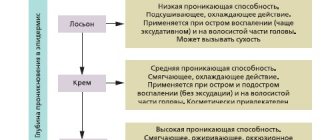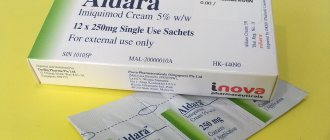Naftifine 1% cream for external use, 30g (Tula pharmaceutical factory)
Registration Certificate Holder
TULA PHARMACEUTICAL FACTORY (Russia)
Dosage form
Medicine - Naftifin
Description
Cream for external use 1%
white, uniform, shiny, with a weak characteristic odor.
1 g
naftifine hydrochloride 10 mg
Excipients
: sodium hydroxide - 1.2 mg, benzyl alcohol - 10 mg, sorbitan stearate - 19 mg, cetyl palmitate - 20 mg, cetyl alcohol - 40 mg, stearyl alcohol - 40 mg, polysorbate 60 - 61 mg, isopropyl myristate - 80 mg, purified water - up to 1000 mg.
10 g - aluminum tubes (1) - cardboard packs. 15 g - aluminum tubes (1) - cardboard packs. 20 g - aluminum tubes (1) - cardboard packs. 25 g - aluminum tubes (1) - cardboard packs. 30 g - aluminum tubes (1) - cardboard packs. 40 g - aluminum tubes (1) - cardboard packs. 50 g - aluminum tubes (1) - cardboard packs. 60 g - aluminum tubes (1) - cardboard packs. 70 g - aluminum tubes (1) - cardboard packs. 80 g - aluminum tubes (1) - cardboard packs. 90 g - aluminum tubes (1) - cardboard packs. 100 g - aluminum tubes (1) - cardboard packs.
Indications
Onychomycosis, pityriasis versicolor, epidermophytosis of large skin folds and feet, rubromycosis, trichophytosis, microsporia, skin candidiasis, mycoses with secondary bacterial infection.
Contraindications for use
Hypersensitivity to naftifine.
pharmachologic effect
Antifungal agent, belongs to allylamines. The mechanism of action is associated with inhibition of ergosterol biosynthesis, which leads to disruption of the synthesis of the pathogen cell wall. It has a fungicidal effect on dermatophytes, molds, and sporotrichosis pathogens. It has a fungicidal or fungistatic effect on yeast fungi, depending on the specific strain. It has antimicrobial activity against various gram-positive and gram-negative microorganisms, which are often combined with fungi. Has an anti-inflammatory effect, reduces itching. It is characterized by a prolonged action (up to 24 hours).
Dosage regimen
Individual, applied externally 1-2 times/day, duration of treatment varies from 2 weeks to 6 months.
Side effect
In some cases:
at the site of application, dryness and redness of the skin, a burning sensation.
Use during pregnancy and breastfeeding
Restrictions during pregnancy - With caution.
Use during pregnancy in recommended doses does not have an adverse effect on the fetus.
Mistakes in treating toenail fungus
Nail fungus or onychomycosis is an unpleasant disease that may not be noticed immediately. The fungus destroys your nail plate, causing discomfort and pain; if treatment for onychomycosis is started, this can lead to soft tissue pathologies. The fungus can easily spread to healthy fingernails or toenails, and this poses a great danger to your health and the health of others.
If you have any doubts about the health of your nails, the best thing to do is make an appointment with a dermatologist. Only with complex treatment, consisting of a course of medication, regular foot hygiene and special treatment of the nail plates, will the treatment bring a positive result.
Main symptoms of fungal infections:
● Brittle, rough nails
● Deformation of the nail plate
● Presence of inflamed tissue around the nail
● Delamination, thickening or thinning of the nail plate
● Presence of brown, black or yellow areas on the nails.
How do you get nail fungus?
Ways of infection with onychomycosis. If you follow the rules of hygiene, have good immunity, and have healthy and well-groomed skin, the risk of contracting a fungal infection is not high. The fungus often enters the body through abrasions, cuts, cracks, and altered injured areas of the nails and skin. Excessive sweating or dry skin, or wearing tight shoes can contribute to the growth of the fungus.
You are more vulnerable to nail fungus if:
● You have varicose veins
● Reduced immunity
● You wear rubber shoes that don't breathe
● There are endocrine and vascular diseases
● Have been in contact with a person infected with a fungus
● There is flat feet.
What danger does toenail fungus pose to humans?
At an advanced stage of onycochomycosis, nail fungus causes an allergic reaction, has an intoxicating effect on the body, and can affect internal organs.
How to cure nail fungus?
When treating nail fungus, local medications can be used - creams, ointments, patches, which can also be used at home. Various spray options are available that have strong antifungal, anti-inflammatory and antiseptic properties.
At the early stage of the disease, the use of sprays or creams is recommended. Do not forget that treating nail fungus is not only about getting rid of external manifestations. During treatment, the dermatologist prescribes systemic medications. The drug can be prescribed in the form of tablets, which will be taken for a course of three to six months.
The most common mistakes when treating toenail fungus.
The moisture of your feet. Fungus in the form of spores is everywhere around us. When the skin humidity is more than 80%, fungal spores begin to multiply and infect the nail plate and surrounding skin.
The presence of fungal spores on things. When ironing socks with steam, you kill the active fungal spores remaining there. If this is not done, then from the spores, in the presence of damp skin of the feet (favorable environment), high humidity of the shoes, the fungus actively begins to multiply.
Shoe hygiene. When starting treatment for nail fungus, be sure to treat all the shoes you wear. Use a personal towel intended only for feet.
Remains of fungal spores on instruments. All tools for cutting nails must be treated with disinfecting solutions; it is recommended to use disposable files to care for affected nails. If the fungal spores remain on the tools, then you can manually remove them for years, cut out traces of the fungus along with your nail, but this will not bring any results.
What should you follow when treating toenail fungus?
If you do not follow the recommendations during treatment of nail fungus, a relapse may occur. Try to always keep your feet clean and change your socks daily. It is important for your feet to wear the right shoes to prevent your feet from getting sweaty. After taking any water procedures, wipe your feet dry, paying special attention to the area between the toes.
Use an individual foot towel, which must be dried after use. If your shoes become wet, dry them immediately. It is recommended to change indoor shoes at least twice a year during treatment. Foot baths with soda and salt will also be useful. Feet should be washed daily using laundry or tar soap.
Always follow the rules of hygiene when visiting public places: saunas, baths, hammam, swimming pools. Do not self-medicate; it would be best to contact a dermatologist who will prescribe a course of treatment for you so that you can quickly get rid of toenail fungus and save your time and nerves.
Naftifine 25 ml
Dosage form
Solution for external use
Composition per 1 ml:
Active substance
: naftifine hydrochloride – 10 mg.
Excipients
: propylene glycol – 50 mg, ethanol (ethyl alcohol 95%) – 400 mg, purified water – up to 1 ml.
Description
A clear, colorless or slightly yellow solution with an ethanol odor.
Pharmacotherapeutic group
Antifungal agent
ATX code: D01AE22.
Pharmacological properties
Pharmacodynamics
Naftifine is an antifungal agent for external use, belonging to the class of allylamines. The mechanism of action is associated with inhibition of squalene-2,3-epoxidase, which leads to a decrease in the formation of ergosterol, which is part of the cell wall of the fungus. Active against dermatophytes such as Trichophyton, Epidermophyton, Microsporum, mold fungi ( Aspagillus spp.
), yeasts (
Candida spp., Pityrosporum
) and other fungi (for example,
Sporothrix schenckii
). Naftifine has a fungicidal effect against dermatophytes and aspergillus. Against yeast fungi, the drug exhibits fungicidal or fungistatic activity depending on the strain of the microorganism. It has antibacterial activity against gram-positive and gram-negative microorganisms that can cause secondary bacterial infections. It has an anti-inflammatory effect, which contributes to the rapid disappearance of symptoms of inflammation, especially itching.
Pharmacokinetics
When used externally, it penetrates well into the skin, creating stable antifungal concentrations in its various layers, which makes it possible to use the drug once a day.
Indications for use
- fungal infections of the skin and skin folds (tinea corporis, tinea inquinalis);
— interdigital mycoses (tinea manum, tinea pedum);
- fungal nail infections (onychomycosis);
- skin candidiasis;
- pityriasis versicolor (pityriasis versicolor);
- ringworm (with or without accompanying itching).
Contraindications
Hypersensitivity to naftifine or other components of the drug. Pregnancy and breastfeeding (safety and effectiveness have not been established).
Application to the wound surface.
Carefully
Children's age (experience of clinical use is limited).
Use during pregnancy and breastfeeding
The use of the drug during pregnancy and breastfeeding is contraindicated (the safety and effectiveness of naftifine in this category of patients has not been studied).
Directions for use and doses
Externally.
For skin lesions
The drug Naftifin is applied once a day to the affected skin surface and adjacent areas (approximately 1 cm of healthy skin at the edges of the affected area) after thoroughly cleaning and drying them.
The duration of therapy for dermatomycosis is 2-4 weeks (up to 8 weeks if necessary), for candidiasis - 4 weeks.
When nails are affected
The drug Naftifin is applied 2 times a day to the affected nail. Before the first use of the drug, remove as much of the affected part of the nail as possible with scissors or a nail file.
The duration of therapy for onychomycosis is up to 6 months.
To prevent relapse, treatment should be continued for at least 2 weeks after the disappearance of clinical symptoms.
If there is no improvement after treatment or new symptoms appear, you should consult your doctor. Use the drug only according to the method of use and in the doses indicated in the instructions. If necessary, please consult your doctor before using the medicine.
Side effect
In some cases, local reactions may be observed: dry skin, skin hyperemia (redness) and burning. Side effects are reversible and do not require discontinuation of treatment. If any of the side effects indicated in the instructions worsen, or any other side effects not listed in the instructions are noted, you should immediately inform your doctor.
Overdose
When using the drug in accordance with the instructions for use, an overdose is unlikely. In case of accidental ingestion, gastric lavage and symptomatic therapy are indicated.
Interaction with other drugs
Interaction with other drugs has not been studied.
special instructions
The drug Naftifin is not intended for use in ophthalmology. The drug should not come into contact with the eyes.
To achieve a therapeutic effect, a course of treatment is required.
The drug Naftifin is effective in the treatment of mycoses affecting areas of the skin with hyperkeratosis, as well as in areas of hair growth.
Propylene glycol contained in the solution may cause skin irritation; If side effects occur, you should stop using the drug and consult a doctor.
The effect of the drug on the ability to drive vehicles and machinery
The drug Naftifin does not have a negative effect on the ability to drive vehicles and perform other activities that require concentration and speed of psychomotor reactions.
Release form
Solution for external use 1%.
10 ml, 12 ml, 15 ml, 20 ml, 30 ml in dark glass bottles, sealed with polyethylene dropper stoppers and polyethylene caps with or without first opening control or sealed with plastic dropper stoppers and caps, or polymer caps and polyethylene caps or plastic, polymer or polyethylene closures.
A label is placed on the bottle.
Each bottle, along with instructions for medical use, is placed in a cardboard pack.
Storage conditions
At a temperature not higher than 25 °C.
Keep out of the reach of children.
Best before date
3 years.
Do not use after the expiration date stated on the packaging.
Vacation conditions
Available without a prescription.

